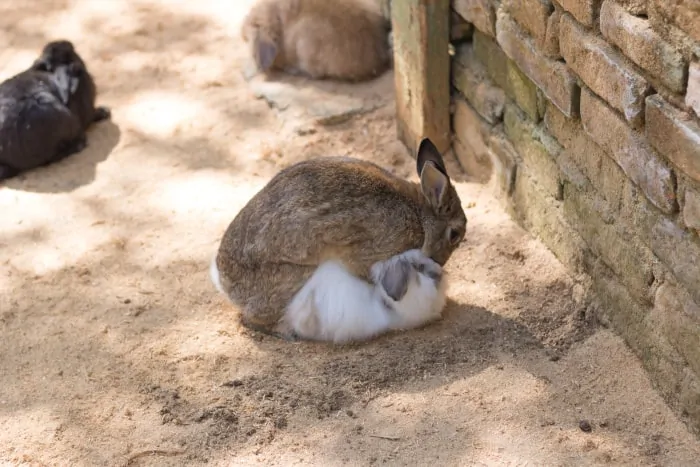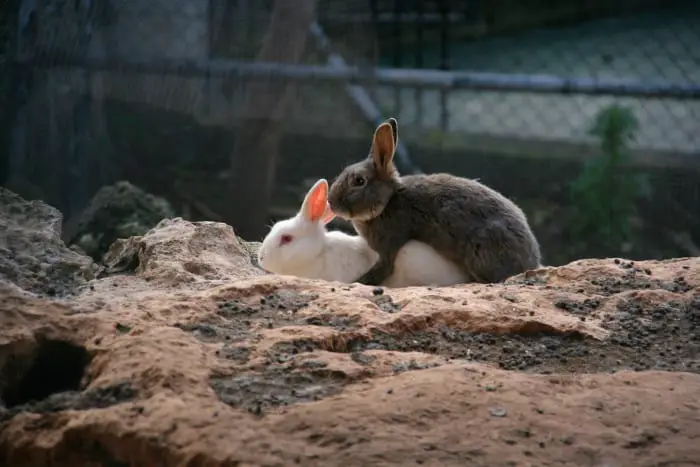Pet rabbits are particularly well known for their mating. Their reproduction rate is phenomenal to say the least so it makes sense to learn more about how rabbits mate. If you have a doe (female) and buck (male), before long you can expect to have many baby bunnies running around! If you are a pet owner who is interested in breeding your bunnies, you have come to the right place. Here we will discuss everything you need to know about the reproductive process of your beloved pet rabbits.
How old are rabbits when they reach sexual maturity?
Pet rabbits reach sexual maturity on average between the age of 3 months (90 days) to 6 months (180 days). However, pet owners are discouraged from allowing their rabbits to mate at 3 months. If you allow your doe to start breeding at this early age, their physical growth may be curtailed. Some breeders decide to start breeding when their rabbits reach a particular weight rather than age. The age may also vary slightly depending on the breed of rabbit that you have. Here is a guide regarding the different breeds and the ideal age that they are ready to reproduce.
- Giant Breeds – These would include breeds like the French Lop, Giant Chinchilla, Flemish Giant, and Checkered Giant. These bunnies reach sexual maturity around 8 months. You may wonder why so long. The reason is simple: these bunnies reach physical maturity around this age.
- Large Breeds – Examples of rabbits in this category are the Palomino, Californian, New Zealand, and Champagne d’ Argent. They usually reach sexual maturity around 6 to 7 months of age.
- Medium breeds – These are your average size bunnies. Some examples of these breeds are Dutch, Mini Lop, Havana, and Florida White. These pet rabbits reach their sexual maturity between 5 and 6 months.
- Miniatures or dwarf breeds – These pint-size pets rabbits like the Dwarf Hotot, Netherland Dwarf, Britannia Petite, Polish, and Holland Lop to name a few reach their sexual maturity between 4 and 5 months.
So as you can tell by now, the rate of sexual maturity is not a one size fits all when it comes to pet rabbits. If you are keen on your rabbits reproducing. You have to make the decision that is right for your rabbit breed.
Do rabbits have a mating ritual?
Yes, they do! Rabbits perform a mating dance which involves interaction between the doe and buck, ending in the doe signaling to the male that he is an acceptable candidate and the mating can begin. Now if you have a buck and doe they are probably going to choose each other without to much fuss. However, the mating dance is a ritual that they will instinctively perform. Here is a bit of insight into what it looks like.
- Step 1 – The female bunny secretes her pheromones that drift on the air. The buck will pick up this scent and know he can begin courting the doe.
- Step 2 – They pet rabbits will sniff each other. Frankly, we believe that this is to ensure that the potential mate is a member of the opposite sex.
- Step 3 – Then it’s off to the races! Usually, the doe dashes off with the buck right on her fluffy little tail.
- Step 4 – If the doe accepts the buck, she will turn around and box the buck with her front paws. This little boxing match will continue until one of the bunnies jumps into the air. The second rabbit will then do the same leap and this means that mating can begin.
- Step 5 – There may be a bit of nipping and circling right before the mating begins. If the buck and the doe are not compatible, that is to the say that the doe is not particularly interested in the buck. There may be fights at this point. If things seem to be getting heated, you can throw a towel to break the warring bunnies up.
- Step 6 – If the nipping and circling phase go well, The buck may urinate on the doe (I know. What kind of foreplay is that?) the male will mount the female.
- Step 7 – After they complete the mating, the buck may fall to one side. Then, the bunnies may relax into amicable companionship, licking and grooming each other.
How long does the mating process actually take for rabbits?
The crucial act for reproduction does not last long to be honest if you turn away for a bit, you just may miss it. The mating itself lasts roughly between 20- 40 seconds.

How many times per day can a buck mate?
It is natural to focus on pregnant females when thinking about reproduction. However, if you want to optimize your kit production, you need to know what your bucks, in particular, are capable of. You can use a buck for breeding twice a day, no exceeding 7 times for the week. If your buck mates, for instance, three times a day, chances are the last female rabbit for the day may not get pregnant. As such, some breeders opt only to use their buck 2 to 3 times a week so that pregnancies are more or less guaranteed when mating does occur.
What are the signs that a doe exhibits when she is ready to mate?
It takes two to tango and both parties must be receptive in order for reproduction to occur. A doe will exhibit signs that you and the potential mate can detect. Here are the signs to look for.
- Restless behavior – She may rub her chin on objects around her like her water bowl or feed container. She may show an interest in socializing with other bunnies.
- Swollen genitalia – The doe’s vulva may appear slightly swollen and reddish in color.
- Presenting – Your doe may lie on her stomach and lift her tail when she is touched. This is her way of presenting herself to any eligible bucks around.
Do rabbits make any sound while mating?
Pet rabbits do not make noises while they are mating. However, they do make a honking noise when they are wooing a potential mate. A buck will often honk at a female that he is interested in mating with. Honking is a sound that rabbits make when they are happy and excited.
What are some of the rules you should follow as a breeder when it comes to mating?
There are certain rules of thumb that you should follow when you are facilitating the mating process with your pet rabbits. Let’s take a look at them.
- Always put the female in the male’s cage – This is important since female rabbits are very territorial. If you place a male in her cage, she will probably fight him. This is something that catches many new breeders by surprise.
- Put the doe and buck together again about 10 hours later – This may seem strange, but mating stimulates ovulation, and breeders believe that this actually increases litter size.
Are there any problems that rabbits face when trying to mate/reproduce?
The goal of mating is to achieve reproduction. Of course, like any process, there may be glitches that may hinder the reproductive process from resulting in a successful pregnancy. Here are a few of the hiccups that a pet owner or breeder may encounter along the way.
- High temperatures – Exposure to elevated temperatures can result in temporary sterility in bucks. When bucks are exposed to temperatures higher than 85F for days on end, their sperm production/count is adversely affected. Their fertility may be affected for up to 90 days. During summer months, you should try to keep your bucks in the coolest parts of your home or yard. The older bucks are more susceptible to this issue.
- Seasonal Issues – Apparently rabbits mate less during late summer, fall, and the beginning of winter. There is no easy workaround with this one. The experience breeders will tell you that you should simply let the bunnies who have a good track record of pregnancies year-round mate during these months.
- Pseudopregnancy – This is the medical term for false pregnancies. It simply means that your pet rabbit may appear pregnant, but in actuality, she is not. This may occur when a sterile buck has mounted the doe. The female rabbit will behave as if she is pregnant, she may even start nesting. These behaviors may last as long as 17 days. The doe will not suffer any ill effects during this time. However, she will not mate with any buck when she believes she is pregnant.
- Physical challenges – Your bunnies may have physical issues that may affect their ability to reproduce. Obese bucks tend to lack libido ( the zeal to mate). A doe may fail to get pregnant if she has not been mated in a long time. If your rabbits are sick, old, injured or their nutrition is not up to par, they may fail to reproduce.
So now that you know what to expect when your pet rabbits are mating, you can now facilitate optimal reproduction. Once your bunnies are healthy and you do not mate them too often. A mating session will result in a successful pregnancy. As such you can look forward to a litter of kits in the near future.



